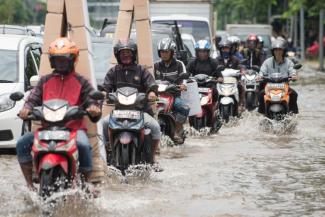Environment
City shores

Jakarta is in trouble. The special capital region of Indonesia was home to almost 10 million people in 2010, and the number keeps growing. Some of the agglomeration’s territory is below sea level, and the share is increasing because of subsidence: as groundwater is being extracted excessively, land is slowly sinking lower.
In Jakarta, flooding can have two reasons: storm surges make sea water pour in, and after heavy rains, the rivers swell. Sometimes, both happens at once. Compounding problems, the city’s canals are old and all too often used for waste disposal, so garbage clogs the overburdened system precisely when drainage is needed most.
It adds to the problems, that coastal mangroves have been largely cleared so their coastal protection has been lost. A nearby coral reef has also been destroyed. At the same time, ever more people want to live in Jakarta, and population density is increasing, particularly in informal settlements. It is no coincidence, of course, that some slums are located in flood-prone areas.
Jakarta’s problems are assessed in a short case study in a book edited by Mark Pelling and Sophie Blackburn (2013). They are some of the typical challenges coastal megacities must tackle. Precisely how the problems combine, is different in every city. Rio de Janeiro, for example, has steep slopes on which poor communities live, so landslides cause disasters of a kind that cannot occur in Mumbai, which was built on low-lying islands and reclaimed land.
Coastal megacities are not only affected by global warming, however, they also contribute to the phenomenon. They tend to be transport nodes as well as hubs of industrialisation. Emissions from vehicles, factories and power stations contribute to climate change and worsen local air pollution. Water pollution causes problems too, of course, affecting marine ecosystems.
Megacities are highly complex systems. They are difficult to govern and very hard to plan, but the quality of cities will determine the future of humankind (see interview with Dirk Messner in D+C/E+Z e-Paper 2016/10). Generally speaking, the faster an agglomeration grows, the greater the challenges are.
Pelling and Blackburn’s book is based on globally coordinated research efforts. The editors relied on several dozens of contributors from around the world. The goal was to understand the environmental issues that coastal megacities face, and the book does provide substantial information. It is not easy to read, however, and some additional editing would have helped to make it accessible to a general public. Sometimes, the syntactic complexity of the essays seems to be striving to compare to the complexities of coastal ecosystems and megacity development.
Reference
Pelling, M., and Blackburn, S. (eds.), 2013: Megacities and the coast. London and New York: Routledge














